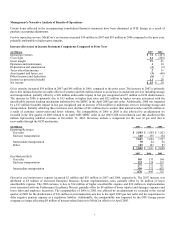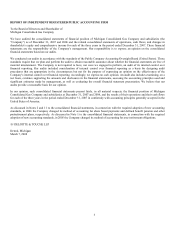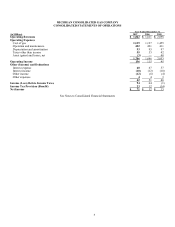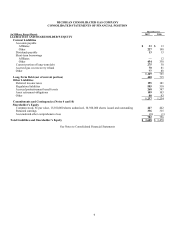DTE Energy 2007 Annual Report Download - page 13
Download and view the complete annual report
Please find page 13 of the 2007 DTE Energy annual report below. You can navigate through the pages in the report by either clicking on the pages listed below, or by using the keyword search tool below to find specific information within the annual report.
Asset Retirement Obligations
We record asset retirement obligations in accordance with Statement of Financial Accounting Standards (SFAS) No. 143, Accounting
for Asset Retirement Obligations and Financial Accounting Standards Board Interpretation No. (FIN) 47, Accounting for Conditional
Asset Retirement Obligations, an interpretation of FASB Statement No. 143. We have conditional retirement obligations for gas
pipeline retirement costs. To a lesser extent, we have conditional retirement obligations at certain service centers, compressor and gate
stations. The Company recognizes such obligations as liabilities at fair market value at the time the associated assets are placed in
service. Fair value is measured using expected future cash outflows discounted at our credit-adjusted risk-free rate.
The adoptions of SFAS No. 143 and FIN 47 resulted primarily in timing differences in the recognition of legal asset retirement costs
that we are currently recovering in rates. We defer such differences under SFAS No. 71, Accounting for the Effects of Certain Types of
Regulation.
As a result of adopting FIN 47 on December 31, 2005, we recorded a plant asset of $13 million with offsetting accumulated
depreciation of $4 million, and an asset retirement obligation liability of $92 million. We also recorded a cumulative effect amount as
a reduction to a regulatory liability of $84 million.
No liability has been recorded with respect to lead-based paint, as the quantities of lead-based paint in our facilities are unknown. In
addition, there is no incremental cost for demolitions of lead-based paint facilities vs. non-lead-based paint facilities and no
regulations currently exist requiring any type of special disposal of items containing lead-based paint.
A reconciliation of the asset retirement obligation for 2007 follows:
(in Millions)
Asset retirement obligations at January 1, 2007 $ 103
Accretion 7
Liabilities settled (1)
Asset retirement obligations at December 31, 2007 $ 109
Long-Lived Assets
Our long-lived assets are reviewed for impairment whenever events or changes in circumstances indicate the carrying amount of an
asset may not be recoverable. If the carrying amount of the asset exceeds the expected future cash flows generated by the asset, an
impairment loss is recognized resulting in the asset being written down to its estimated fair value. Assets to be disposed of are
reported at the lower of the carrying amount or fair value less cost to sell.
Excise and Sales Taxes
We record the billing of excise and sales taxes as a receivable with an offsetting payable to the applicable taxing authority, with no
impact on the Consolidated Statements of Operations.
Deferred Debt Costs
The costs related to the issuance of long-term debt are deferred and amortized over the life of each debt issue. In accordance with
MPSC regulations, the unamortized discount, premium and expense related to debt redeemed with a refinancing are amortized over
the life of the replacement issue.
Insured and Uninsured Risks
Our comprehensive insurance program provides coverage for various types of risks. Our insurance policies cover risk of loss from
property damage, general liability, workers’ compensation, auto liability and directors’ and officers’ liability. Under our risk
management policy, we self-insure portions of certain risks up to specified limits, depending on the type of exposure. We have an
actuarially determined estimate of our incurred but not reported liability prepared annually and adjust our reserves for self-insured
risks as appropriate.
11
























